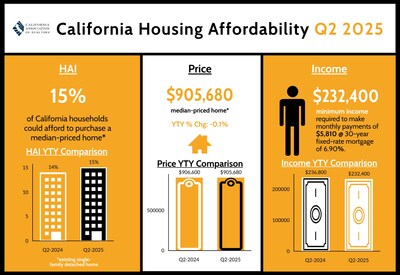California housing affordability dips in second-quarter 2025, improves from year ago, C.A.R. reports
- Fifteen percent of California households could afford to purchase the $905,680 median-priced home in the second quarter of 2025, down from 17 percent in first-quarter 2025 and up from 14 percent in second-quarter 2024.
- A minimum annual income of $232,400 was needed to make monthly payments of $5,810, including principal, interest, taxes and insurance on a 30-year fixed-rate mortgage at a 6.90 percent interest rate.
- Twenty-five percent of home buyers were able to purchase the $670,000 median-priced condo or townhome. A minimum annual income of $172,000 was required to make a monthly payment of $4,300.
SACRAMENTO, Calif., Aug. 12, 2025 /PRNewswire/ -- Elevated interest rates and higher home prices curbed California housing affordability in the second quarter of 2025, the CALIFORNIA ASSOCIATION OF REALTORS® (C.A.R.) said today.
Infographic: https://www.car.org/Global/Infographics/HAI-2025-Q2
Fifteen percent of the state's homebuyers could afford to purchase a median-priced, existing single-family home in California in second-quarter 2025, down from 17 percent in the first quarter of 2025 and up from 14 percent in the second quarter of 2024, according to C.A.R.'s Traditional Housing Affordability Index (HAI). Housing affordability in California remained near its all-time low and continued to be a challenge for both buyers and sellers.
The second-quarter 2025 figure is less than a third of the affordability index peak of 56 percent in the second quarter of 2012. C.A.R.'s HAI measures the percentage of all households that can afford to purchase a median-priced single-family home in California. C.A.R. also reports affordability indices for regions and select counties within the state. The index is considered the most fundamental measure of housing well-being for home buyers in the state.
After increasing for two consecutive quarters, the effective interest rate declined from both the previous quarter and second-quarter 2024. The average effective interest rate decreased to 6.90 percent in the second quarter of 2025 from 6.93 percent in the first quarter of 2025 and was down from 7.10 percent in the second quarter of 2024. Mortgage rates fluctuated in the first half of this year as economic uncertainties induced by tariff concerns continue to linger. Rates have moderated since late July. Over the next six months, rates are expected to ease further as recent signs of weakness suggest that the economy will continue to slow in the third quarter of 2025 and possibly into fourth-quarter 2025. However, with the average effective tariff rate sharply higher than what it was late last year and at the highest level since 1933, consumer prices will likely increase further, and inflation will become a bigger issue in the second half of the year. As such, the Federal Reserve could face a challenge between controlling inflation and boosting job growth in the coming months.
While dipping below the previous quarter and the like quarter a year ago, mortgage rates continued to stay elevated, keeping borrowing costs near their all-time highs. The monthly mortgage payment on a median-priced home (including taxes and insurance) jumped 6.6 percent from the previous quarter but slipped 1.9 percent from the second quarter of 2024 as the effective mortgage rate dipped 20 basis points from a year ago.
A minimum annual income of $232,400 was needed to qualify for the purchase of a $905,680 statewide median-priced, existing single-family home in the second quarter of 2025. The monthly payment, including taxes and insurance (PITI) on a 30-year, fixed-rate loan, would be $5,810, assuming a 20 percent down payment and an effective composite interest rate of 6.90 percent.
The statewide median price of an existing single-family California home jumped 6.9 percent quarter-to-quarter, partly due to seasonal factors. On a year-over-year basis, California recorded its first price decrease in eight quarters, as slower demand and improved housing supply led to softer home prices. As the market transitions out of the spring homebuying season, home prices are expected to moderate further as market competition cools. With more price declines expected in the months ahead, housing affordability could see a slight improvement in the next couple of quarters.
More California households (25 percent) could afford a typical condo/townhome in second-quarter 2025, rising from 24 percent in first-quarter 2025 and 22 percent in second-quarter 2024. An annual income of $172,000 was required to make the monthly payment of $4,300 on the $670,000 median-priced condo/townhome in the second quarter of 2025.
Compared with California, more than one-third (34 percent) of the nation's households could afford to purchase a $429,400 median-priced home, which required a minimum annual income of $110,400 to make monthly payments of $2,760. Nationwide, affordability declined from 37 percent in the first quarter of 2025 but increased from 34 percent a year ago. In the second quarter of 2025, the nationwide minimum required annual income was less than half that of California's for the ninth consecutive quarter.
Key points from the Second-Quarter 2025 Housing Affordability report include:
- Compared to the previous quarter, housing affordability in the second quarter declined in 23 counties and remained unchanged in 14. Despite higher home prices, 16 counties showed a quarter-to-quarter improvement in affordability as a result of slightly lower mortgage rates and higher levels of income. When compared to a year ago, housing affordability improved in many counties across the state with 41 counties experiencing an improvement in affordability, while 12 counties either declined or showed no improvement.
- Lassen (46 percent) remained the most affordable county in California, followed by Glenn (39 percent) and Tuolumne (38 percent), where nearly two out of five households in those counties could afford to purchase the median-priced home in their respective county in the second quarter. Of all counties in California, Lassen continued to require the lowest minimum qualifying income ($73,200) to purchase a median-priced home in the second quarter of 2025.
- Mono (8 percent), was the least affordable county in California, followed by Monterey and Santa Barbara (both at 10 percent), with each of them requiring a minimum income of at least $232,800 to purchase a median-priced home in the respective county. San Mateo (16 percent) continued to require the highest minimum qualifying income ($564,800) to buy a median-priced home in second-quarter 2025. Together with Santa Clara (17 percent), they were the only two counties in California requiring a minimum qualifying income of over $500,000. San Francisco (19 percent) came in third with a minimum required income of $459,200.
- A near-all-time high cost of borrowing remains a hurdle for improvements in housing affordability in many parts of the state. In the second quarter of 2025, the housing affordability index of 23 percent of the counties tracked by C.A.R. either remained unchanged or declined from the like quarter a year ago. Lassen (46 percent) experienced the biggest year-to-year drop, falling six percentage points. Tehama (29 percent) and Del Norte (29 percent) followed closely, with each declining five points from a year ago. Despite improving from a year ago, housing affordability remained near its all-time low and continued to be a challenge for both buyers and sellers.
See C.A.R.'s historical housing affordability data.
See first-time buyer housing affordability data.
Leading the way…® in California real estate for 120 years, the CALIFORNIA ASSOCIATION OF REALTORS® (www.car.org) is one of the largest state trade organizations in the United States with 180,000 members dedicated to the advancement of professionalism in real estate. C.A.R. is headquartered in Sacramento.
CALIFORNIA ASSOCIATION OF REALTORS® | ||||||||
2nd Quarter 2025 | C.A.R. Traditional Housing Affordability Index | |||||||
STATE/REGION/COUNTY | 2nd Qtr. 2025 | 1st Qtr. 2025 | 2nd Qtr. 2024 | Median | Monthly | Minimum | ||
Calif. Single-family home | 15 | 17 | 14 | $905,680 | $5,810 | $232,400 | ||
Calif. Condo/Townhome | 25 | 24 | 22 | $670,000 | $4,300 | $172,000 | ||
Los Angeles Metro Area | 14 | 15 | 13 | $850,000 | $5,460 | $218,400 | ||
Inland Empire | 21 | 21 | 20 | $610,000 | $3,910 | $156,400 | ||
San Francisco Bay Area | 20 | 21 | 18 | $1,400,000 | $8,980 | $359,200 | ||
United States | 34 | 37 | 33 | $429,400 | $2,760 | $110,400 | ||
San Francisco Bay Area | ||||||||
Alameda | 19 | 19 | 16 | $1,350,000 | $8,660 | $346,400 | ||
Contra Costa | 23 | 25 | 21 | $915,000 | $5,870 | $234,800 | ||
Marin | 19 | 20 | 16 | $1,770,000 | $11,360 | $454,400 | ||
Napa | 15 | 14 | 14 | $950,000 | $6,100 | $244,000 | ||
San Francisco | 19 | 20 | 19 | $1,788,000 | $11,480 | $459,200 | ||
San Mateo | 16 | 16 | 16 | $2,200,000 | $14,120 | $564,800 | ||
Santa Clara | 17 | 17 | r | 16 | $2,138,000 | $13,720 | $548,800 | |
Solano | 27 | 26 | 24 | $583,940 | $3,750 | $150,000 | ||
Sonoma | 17 | 18 | 16 | $855,000 | $5,490 | $219,600 | ||
Southern California | ||||||||
Imperial | 27 | 27 | r | 26 | $397,450 | $2,550 | $102,000 | |
Los Angeles | 13 | 13 | 13 | $879,900 | $5,650 | $226,000 | ||
Orange | 12 | 12 | 11 | $1,431,500 | $9,190 | $367,600 | ||
Riverside | 21 | 20 | 19 | r | $640,000 | $4,110 | $164,400 | |
San Bernardino | 29 | 28 | 27 | r | $491,000 | $3,150 | $126,000 | |
San Diego | 13 | 12 | 11 | $1,025,000 | $6,580 | $263,200 | ||
Ventura | 14 | 14 | 12 | $965,750 | $6,200 | $248,000 | ||
Central Coast | ||||||||
Monterey | 10 | 10 | 8 | $935,000 | $6,000 | $240,000 | ||
San Luis Obispo | 12 | 11 | 11 | $920,000 | $5,900 | $236,000 | ||
Santa Barbara | 10 | 9 | 9 | $1,397,000 | $8,970 | $358,800 | ||
Santa Cruz | 14 | 15 | 13 | $1,320,000 | $8,470 | $338,800 | ||
Central Valley | ||||||||
Fresno | 30 | 29 | 28 | $435,000 | $2,790 | $111,600 | ||
Glenn | 39 | 40 | 35 | $335,900 | $2,160 | $86,400 | ||
Kern | 30 | 30 | 30 | $405,000 | $2,600 | $104,000 | ||
Kings | 34 | 33 | 29 | $365,000 | $2,340 | $93,600 | ||
Madera | 31 | 29 | 29 | $440,000 | $2,820 | $112,800 | ||
Merced | 26 | 26 | 25 | $425,000 | $2,730 | $109,200 | ||
Placer | 30 | 30 | 28 | $675,000 | $4,330 | $173,200 | ||
Sacramento | 27 | 26 | 24 | $550,000 | $3,530 | $141,200 | ||
San Benito | 22 | 27 | 18 | $820,000 | $5,260 | $210,400 | ||
San Joaquin | 26 | 28 | 24 | $565,000 | $3,630 | $145,200 | ||
Stanislaus | 26 | 29 | 25 | $495,000 | $3,180 | $127,200 | ||
Tulare | 30 | 30 | 30 | $385,000 | $2,470 | $98,800 | ||
Far North | ||||||||
Butte | 24 | 28 | 27 | $484,500 | $3,110 | $124,400 | ||
Lassen | 46 | 56 | 52 | $285,000 | $1,830 | $73,200 | ||
Plumas | 34 | 38 | 29 | $410,000 | $2,630 | $105,200 | ||
Shasta | 33 | 32 | 33 | $378,000 | $2,430 | $97,200 | ||
Siskiyou | 37 | 35 | 31 | $302,500 | $1,940 | $77,600 | ||
Tehama | 29 | 33 | 34 | $380,350 | $2,440 | $97,600 | ||
Trinity | 30 | 35 | 28 | $315,500 | $2,020 | $80,800 | ||
Other Calif. Counties | ||||||||
Amador | 35 | 35 | 32 | $435,000 | $2,790 | $111,600 | ||
Calaveras | 33 | 36 | 29 | $468,000 | $3,000 | $120,000 | ||
Del Norte | 29 | 38 | 34 | $410,000 | $2,630 | $105,200 | ||
El Dorado | 27 | 27 | 22 | $699,500 | $4,490 | $179,600 | ||
Humboldt | 23 | 26 | 22 | $445,000 | $2,860 | $114,400 | ||
Lake | 34 | 35 | 31 | $329,000 | $2,110 | $84,400 | ||
Mariposa | 26 | 27 | 25 | $438,500 | $2,810 | $112,400 | ||
Mendocino | 20 | 19 | 17 | $525,000 | $3,370 | $134,800 | ||
Mono | 8 | 5 | 5 | $906,500 | $5,820 | $232,800 | ||
Nevada | 27 | 30 | 24 | $570,000 | $3,660 | $146,400 | ||
Sutter | 27 | 28 | 27 | $450,000 | $2,890 | $115,600 | ||
Tuolumne | 38 | 40 | 31 | $405,000 | $2,600 | $104,000 | ||
Yolo | 22 | 23 | 22 | $659,000 | $4,230 | $169,200 | ||
Yuba | 26 | 25 | 25 | $443,500 | $2,850 | $114,000 | ||
Traditional Housing Affordability Indices (HAI) were calculated based on the following effective composite interest rates: 6.90% (2Qtr. 2025), 6.93% (1Qtr. 2025) and 7.10% (2Qtr. 2024). |
![]() View original content to download multimedia:https://www.prnewswire.com/news-releases/california-housing-affordability-dips-in-second-quarter-2025-improves-from-year-ago-car-reports-302527190.html
View original content to download multimedia:https://www.prnewswire.com/news-releases/california-housing-affordability-dips-in-second-quarter-2025-improves-from-year-ago-car-reports-302527190.html
SOURCE CALIFORNIA ASSOCIATION OF REALTORS® (C.A.R.)



